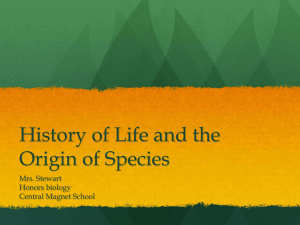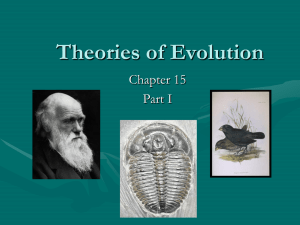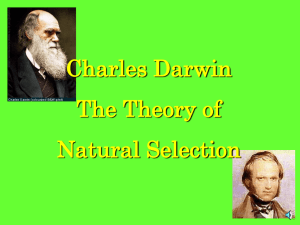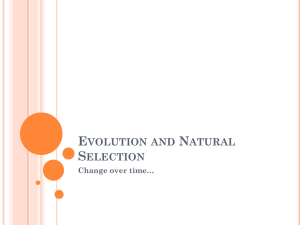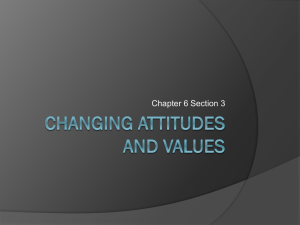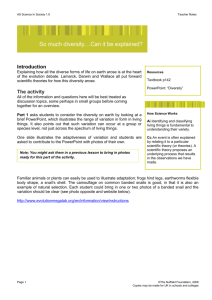History of Life and Evolution ppt
advertisement
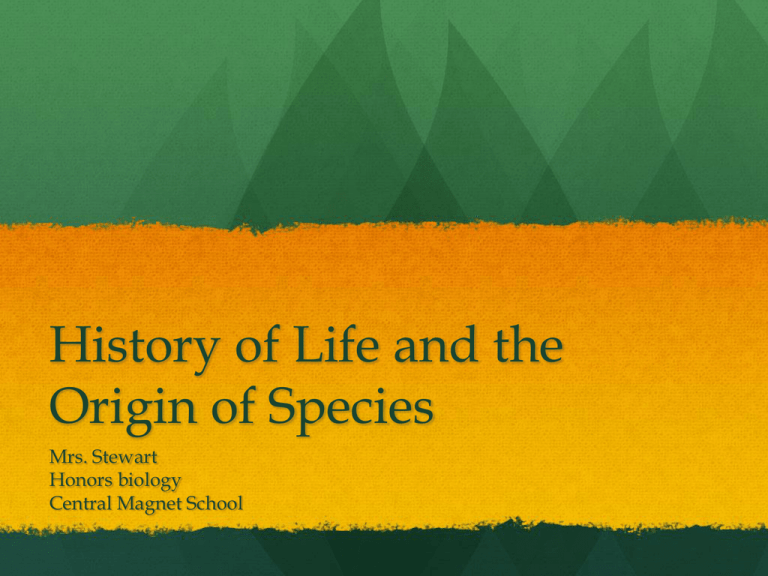
History of Life and the Origin of Species Mrs. Stewart Honors biology Central Magnet School Standards: CCSS ELA 9-10.2 I can trace the historical development of the theory of evolution I can summarize the evidence for the theory of evolution CCSS ELA 9-10.8 I can critique and evaluate competing evolutionary arguments based on scientific knowledge, empirical evidence and logical arguments regarding relevant factors. Objectives (today, I will…) Differentiate between spontaneous generation and biogenesis Differentiate between Charles Darwin and Jean-Baptiste Lamarck Choose… But choose wisely. Decide which partner is the bird and which is the cat. History of Life Biogenesis: All living things come from other living things Spontaneous Generation: Living things could arise from nonliving things Redi’s experiment Previous idea: Flies were created from rotten meat Redi: Meat kept away from adult flies would not produce maggots Spallanzani & Pasteur Spallanzani – tried to disprove that microorganisms arose from a “vital force” in the air Pasteur – improved spallanzani’s experiment to eliminate the flaw of “no air” Cats Tell your bird how Pasteur improved upon Spallanzani’s experiment to disprove spontaneous generation Endosymbiosis Where/how did mitochondria get their own DNA? How did chloroplasts become so specialized? Theory of Endosymbiosis: Aerobic prokaryotes were engulfed by eukaryotic cells evolved into mitochondria (which perform aerobic respiration) Photosynthetic prokaryotes were engulfed by plant cells and evolved into chloroplasts (where photosynthesis occurs) Ch. 15.1 – 15.2 History of Evolution Mrs. Stewart Honors Biology Central Magnet School What is Evolution? Dictionary: The gradual development/change of something; especially from a simple to complex form. Text book: (In biology) Generally, the process of change by which new species develop from pre-existing species over time Evolution of Dance Birds Tell your cat what Evolution means. Give an example (not one that Mrs. Stewart used) th 18 Century Ideas About living species: All species were permanent and unchanging. About the Earth: Earth was only a few thousand years old and unchanging. th 19 Century Ideas Uniformitarianism Idea by Charles Lyell that said geologic processes happed slowly over time and that some features of the Earth may take millions of years to form. Cats Give your bird an example to support Lyell’s theory. Jean-Baptiste Lamarck French Naturalist 1809 Lamarck’s Hypothesis: by selective use or disuse of organs, organisms acquire or lose certain traits. These traits could then be passed on to their offspring. Lamarck believed over time, this process led to change in a species. Lamarck’s Hypothesis 1. Tendency toward perfection - All organisms have an innate tendency toward complexity and perfection, so they are continually changing to be more successful in their environment 2. Use and disuse - Organisms can alter their bodies/organs by use or disuse 3. Inheritance of acquired traits - Organisms can pass on those altered body parts/organs to the offspring Birds What did Lamarck get right? Cats What did Lamarck get wrong? Lamarck the Loser First to develop a hypothesis of evolution First to realize organisms adapt to their environment But, Behavior has no effect on inheritable characteristics Ch. 15.1 – 15.2 History of Evolution Mrs. Stewart Honors Biology Central Magnet School Charles Darwin 1809 – 1882 Naturalist – study of nature and the natural world Sailed on the HMS Beagle in 1831 Every time the ship docked, Darwin went ashore to collect plant and animal specimens Darwin’s observations piqued his interest in the diversity of life he observed. Darwin even found evidence that suggested species once present on earth had vanished. Researchers today speculate that 99.9% of all species that ever inhabited earth are now extinct. Galapagos Islands The islands were close together, but had very different climates Smallest and lowest islands = hot, dry & barren Hood Island = sparse vegetation Higher islands had greater rainfall and a different assortment of plants/animals Isabella Island = rich vegetation Land Tortoise shell shapes could be used to identify which island it inhabited Pinta Island Tortoise What predictions can YOU make observations can about the island YOU make about these species of environment for each land tortoise? Hood Island Tortoise Isabella Island Tortoise Pinta Island Tortoise Which island would you predict has only low-lying vegetation? Hood Island Tortoise Isabella Island Tortoise Darwin’s Idea Darwin observed that the plants and animals varied noticeably among the different Galapagos Islands. However, Darwin wondered if animals living on different islands had once been members of the same species – originating from the same South American ancestor Darwin’s Finches Darwin observed many different types of “finch” and noticed several different beak shapes. Why? He began to notice different shaped beaks were “adaptations” for different food sources Religion’s Role Darwin was a devout Catholic He knew that his ideas, based on what he observed would provoke the catholic church He debated over what to do for 25 years. Darwin’s Theory – Descent With Modification The Origin of Species by Means of Natural Selection – 1858 Every species – living or extinct – descended by reproduction from preexisting species AND Species must be able to change over time Natural Selection Mrs. Stewart Honors biology Central Magnet School Review What was Lamarck’s hypothesis? Inheritance of acquired traits What did Darwin believe? Species changed as environment changed – adaptation and survival of the fittest Standards: CCSS ELA 9-10.2 I can trace the historical development of the theory of evolution I can summarize the evidence for the theory of evolution CCSS ELA 9-10.8 I can critique and evaluate competing evolutionary arguments based on scientific knowledge, empirical evidence and logical arguments regarding relevant factors. Objective (Today I will…) Explain the idea of “natural selection” and determine “fittest” Examine how adaptations help animals survive better Darwin’s reasoning for Natural Selection 1. Overproduction – more offspring are produced than can survive due to competition for resources 2. Genetic Variation – within a population, individuals have different traits. New traits may appear spontaneously. 3. Struggle to survive – constant competition may cause some variations/traits to be advantageous 4. Differential Reproduction – Organisms with the best adaptations will survive and reproduce, thus the advantageous adaptations will become most prevalent in the population. Evolution by Natural Selection Struggle for existence – each member of a species competes regularly for food, living space and other necessities of life. main needs: Food, water, living space and ability to reproduce Who wins? Think – Pair – Share How can we describe Natural Selection in just 4 words? Survival of the Fittest How well suited an organism is to it’s environment Does fittest mean strongest? Does fittest mean in the best shape? Fitness – the ability of an individual to survive and reproduce The result of adaptations What determines fitness? The Environment! Fitness leads to evolution Fitness leads to evolution Peppered Moth evolution Peppered moth virtual lab Survival of the Fittest Fittest – the individuals most capable to survive and reproduce for multiple generations The traits selected as the most useful for survival and reproduction are determined by the organisms environment Natural Selection accounts for Descent with Modification as species become better adapted to different environments. Birds Explain to your cat how the environment can determine fitness – use a specific plant or animal as an example. (Not one Mrs. Stewart gave you) What is a Population? A group of organisms of the same species, that live in the same area, AND that interbreed Adaptation vs. Acclimatization Adaptation - Changes in traits in populations over time Example: White moth population becoming a black moth population after 5 generations. Acclimatization – individual organism changes physiologically Example: growing thicker fur in winter Adaptations Any inherited characteristic that increases an organism’s (and therefore, a populations) ability to survive and reproduce Anatomical or structural characteristics Porcupine quills - protection Longer necks in giraffes – find food Physiological processes How a plant performs photosynthesis Instinctual Behaviors Hunting in packs Living in burrows Can You… Differentiate between biogenesis and spontaneous generation Differentiate between Charles Darwin and Jean-Baptiste Lamarck Explain the idea of “natural selection” and determine “fittest” Evidence of Evolution Mrs. Stewart Honors Biology Central Magnet School Standards: CLE 3210.5.3 – Explain how genetic variation in a population and changing environmental conditions are associated with adaptation and the emergence of new species. Descent with Modification Over long periods of time, natural selection produces organisms with different structures, niches or occupy different habitats than their ancestors. Each living species has descended, with changes, from other species over time. Result: species today look/act different from their ancestors Common Descent Look back: Tigers, panthers and cheetahs all share a common ancestor Look back further: you will find ancestors that these cats share with horses, dogs and bats. Farther back: common ancestors of mammals, birds, alligators and fishes. Logic: looking far enough back we should find the common ancestor for all living things Common Descent Homologous & Analogous Structures Fossil Records Vestigial Structures Evidence of Evolution Molecular Biology Comparative Embryology Fossil Records Fossils - preserved remains of ancient organisms Compare fossils from older layers and younger layers and show changes in species over time Fossil Records Compare fossils found around the world and we can infer when and where different organisms existed. Fossils also provide evidence about the environment in which the organism existed and for which the organism adapted Transitional Species Fossil records show species which have features that are intermediate between those of hypothesized ancestors and later descendant species Homologous vs. Analogous Structures Homologous – refers to structures that share the same basic structure but may differ greatly in function Analogous – refers to structures that vary greatly in structure but may share the same function Homologous Body Structures Homologous Body Structures The limbs of reptiles, birds and mammals (arms, wings, legs and flippers) vary greatly in function but are all constructed from the same basic bones. Analogous Structures Vestigial Structures organs/body parts that were once used, but by natural or artificial selection, are no longer necessary Appendix Vestigial Organs Vestigial Organs Hip bone in a whale Tailbone in humans Vestigial Organs Vestigial Organs Plica Luminaris = Third Eyelid Similarities in Embryology The early stages, or embryos, of many animals with backbones are very similar. Does this mean that a human embryo is ever identical to a fish, or a bird embryo? NO But, many embryos look especially similar during early stages of development. Fish Salamander Tortoise Chicken Pig Man Comparative Embryology What do these similarities mean? The same groups of embryonic cells develop in the same order and in similar patterns to produce the tissues and organs of all vertebrates. All animals go through this process Its at the blastocoel step that we differ Blastopore could become mouth or anus, etc. Molecular Biology Using new technology, we can see how many DNA and RNA sequences organisms share in common Amino acid sequences used to determine how closely related different species are. The number of amino acids that differ from human hemoglobin Molecular Biology Amino Acid Similarities Which two plants are the most closely related according to this chart? Assignment: Evidence of evolution dry lab activity packet Exit Ticket: Socrative.com Room Number: Stewart 348 Question: How does the environment determine the “fittest” individual?
